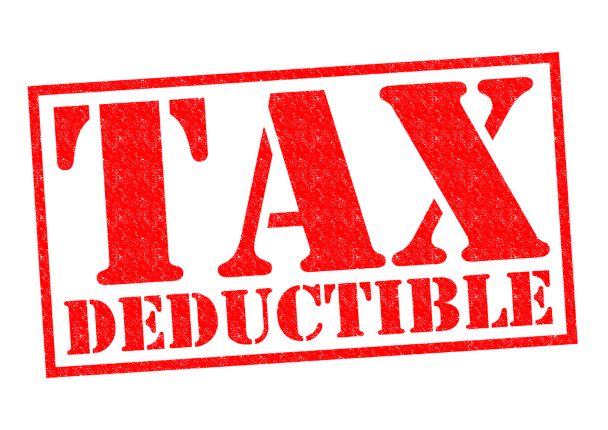12 Top Tax Deductions: Food, Travel, Spending, and More
- January 19, 2024
- 24 min read
-
505 reads
Many people are unaware of the deductions they can take advantage of come tax season. So they overspend and end up owing the government more money.
Don’t let this happen to you! With a little research and planning, you can take full advantage of all the available deductions.
Don’t want to wait? Jump to 12 examples of tax deductions.
What Are Tax Deductions?
Tax deductions refer to expenses you deduct from your taxable income to reduce the amount of taxes you need to pay.
There are two different tax deduction types: standard and itemized deductions.
The Standard Deduction is a fixed amount that can be used to reduce your taxable income and is typically used if the value of your itemized expenses is less than the standard deduction.
Other itemized deductions available are IRA contributions, Health Savings Account (HSA) deductions, state and local taxes, medical expenses, home office deductions, student loan interest deductions, mortgage interest deductions, charitable contributions, and educator’s expense deductions.
Read more: The Biggest Tax Changes for 2023
Types of Tax Deductions
When considering whether to claim a tax deduction, it’s important to consider both the above-the-line and below-the-line deductions available.
Above-the-line deductions refer to income adjustments that reduce your gross income to get to your AGI. Below-the-line deductions will, in turn, get to your gross income by reducing your AGI.
Depending on the type of deduction and your individual circumstances, one type of deduction may be more advantageous for you than the other.
On the other hand, if you own a home, you may want to consider taking the mortgage interest deduction, which is below the line.
In addition, you should consider whether itemizing your deductions or taking the standard deduction is more beneficial.
If you have individual deductions that represent expenses that are higher than standard deductions, you may add them to Schedule A.
It’s important to look at both above-the-line and below-the-line deductions and decide which will provide the greatest benefit for your particular situation.
What Is a Standard Tax Deduction?
A standard tax deduction is a specific portion of your income that is not taxable.
This amount is based on your filing status, age, disability status, or if you’re listed as a dependent on another person’s tax claims.
Examples of Tax Deductions for 2024
1. Tax Deductions for Businesses
Tax deductions are expenses that can be deducted from a business’s taxable income, which helps lower the amount of taxes owed to the government.
Businesses of all sizes can benefit from tax deductions to reduce their income tax bills. Deductions can apply to everything from everyday expenses like advertising and office supplies to larger costs like vehicles, equipment, and insurance.
To take advantage of all the deductions available, it’s best to consult a professional tax accountant.
2. Tax Deductions for Homeowners
Tax deductions for homeowners are deductions that reduce your taxable income, potentially resulting in savings of thousands of dollars each year.
To take advantage of these deductions, you must itemize your deductions on your tax return, which means claiming each deduction separately.
The most common tax deductions for homeowners are mortgage interest, mortgage fees, property taxes, interest on home equity loans, tax exemptions on profits when you sell a home, mortgage insurance, and home office deductions.
These deductions may significantly reduce your tax liability.
You may also be able to deduct a total of up to $10,000 every year for property taxes, state, and local tax, or state income tax. However, married couples filing separately have a lower limit.
Keep in mind, though, that some deductions have been capped or eliminated with the 2017 Tax Cuts and Jobs Act.
3. Tax Deductions for Medical Expenses
- Some medical and dental expenses qualify, however, only if they exceed a total of 7.5% of your AGI.
If you have a lot of medical expenses, some of which may be tax-deductible—for example, driving for medical reasons.
You can also deduct other medical out-of-pocket costs as deductions, including prescriptions and co-pays.
You, your spouse, and any dependents who are covered by your health insurance can all be written off if you are a self-employed business owner. Schedule 1 is added to your Form 1040 and is where these are completed.
To be eligible for a tax deduction, your deductions must be itemized on Schedule A of your income tax return.
Some allowed itemized deductions are medical expenses, taxes, mortgage interest, and charitable gifts.
4. Tax Deductions for Charitable Contributions
For any charitable contributions you make during the year, especially those that total more than $250, keep the receipts. To prove your contribution, the charity might also need to give you an acknowledgment.
You can deduct these costs from your taxable income if you operate as a sole proprietor, LLC, or partnership. However, you can deduct charitable contributions from your taxable income if you are a business.
Your donations to a 501(c)(3) charity, whether in cash or in kind, might be tax deductible.
You can deduct parking fees and tolls paid in addition to 14 cents per mile if you used your automobile for charity during the year.
You may only deduct the amount that exceeds the value of any gifts you received or event tickets you obtained.
Donating used equipment could be tax deductible. You cannot, however, claim a discount if the equipment has already been fully depreciated.
If you itemize personal deductions on your tax return, S companies, LLCs and partnerships can pass the deduction to you so ou can claim it on your own tax return.
A normal (C) corporation that you own may deduct donations made to charity.
5. Tax Deductions for Education
Education-related costs are tax-deductible expenses that can be used to lower your taxable income if they are connected to your present trade, business, or occupation.
These expenditures may include tuition for courses, fees for seminars and webinars, subscriptions to trade publications, books, travel expenses, and more.
The cost of education that qualifies you for a new business or trade is not deductible, and the price must be to maintain or advance abilities required in your current line of work.
Additionally, if your employer provides you with educational assistance benefits worth less than $5,250, you are not required to pay taxes on them.
Tax deductions for education can help you in several ways:
- By lowering the portion of your taxed income, they can reduce the amount of tax you have to pay.
- Based on the interest on your student loans, you might be eligible for a deduction.
- To make home and business energy improvements more reasonable, you can take advantage of energy-related tax benefits.
6. Tax Deductions for Investment Expenses
Some examples of investment expenses that can be claimed as tax deductions include interest expense, home mortgage interest, capital losses, bad debt, and loan interest.
In contrast to home mortgage interest, which can be claimed as an itemized deduction, interest expenses are only deductible to the extent that there is net investment income.
Capital losses and capital gains can be offset against each other.
If the bad debt resulted from an actual debt that was previously included in income, it may also be written off.
Loan interest is tax deductible up to the net investment income.
7. Tax Deductions for Gambling losses
If you are looking to claim a tax deduction for your gambling losses, there are a few steps you need to follow.
Step 1: Itemize your deductions. Your deductions must be itemized to be able to add gambling losses as a deduction. This implies that you must submit Schedule A along with a list of your deductions.
Step 2: Keep records. You should keep records of your gambling losses including all receipts, tickets, and other documentation.
Step 3: Deduct up to the number of gambling winnings. When you file your taxes, you can deduct your gambling losses up to the number of gambling winnings you report as taxable income.
Step 4: Claim other deductions. In addition to deducting gambling losses, there are several other deductions you can claim on your federal income tax return.
These include mortgage interest deductions, retirement plan contributions, HSA contributions, charitable donations, medical and dental costs, state and local tax deductions, and student loan interest deductions.
Some of the credits available to you include:
- Child and Dependent Care Credit
- Child Tax Credit
- American Opportunity Credit
- Saver’s Credit
- Foreign Tax Credit
- Earned Income Tax Credit
Step 5: Claim a capital loss deduction. You can also take advantage of a capital loss deduction, which is not included in the standard or itemized tax deductions. This deduction allows you to deduct losses from the sale of stocks, bonds, or other investments.
Note: Consult with a tax professional if you have any questions or need more information about this deduction.
8. Tax Deductions for Child and Dependent Care
Child and Dependent Care Tax Credit
Parents can use this tax credit to claim up to $3,000 or 35% of qualifying expenses for a child, or, for two or more children, up to $6,000.
This credit applies to children under the age of 13, or to any disabled dependent of any age.
If an elderly parent is living with a child and listed as a dependent on the child’s tax return, expenses related to taking care of that parent may qualify for a deduction.
Dependent Tax Credit
If a dependent doesn’t qualify for the child tax credit there is a $500 tax credit available.
This applies to children over 17 and other adults who are unable to care for themselves due to physical or mental disabilities.
American Opportunity Tax Credit
The American Opportunity tax credit lets parents or guardians claim back up to $2,000 spend on school fees, books, tuition, and equipment, as well as another 25% of the $2,000 after that, for a total of $2,500.
Lifetime Learning Credit
Parents may claim up to $2,000 of the first $10,000 they spent on tuition and fees, or 20% of that amount. This only applies to textbooks or other materials required for courses; it does not apply to living costs or travel.
Student Loan Interest Deduction
Parents may deduct up to $2,500 if they paid interest on their student loans.
Adoption Credit
The adoption credit allows for a maximum of $14,890 in adoption costs per child.
9. Tax Deductions for Retirement Savings
People can lower their taxable income by taking tax deductions for retirement savings. Tax deductions are available for contributions made to regular individual retirement accounts (IRAs), SEP-IRAs, SIMPLE IRAs, and solo 401(k)s as well as contributions made to employee retirement plans as business costs.
The amount of deductions may vary depending on the sort of retirement plan the person has and if they or their spouse are covered by an employer-sponsored retirement plan, even though they can help lower a person’s taxable income.
10. Tax Preparation Fees
The expenses connected with submitting a tax return are tax preparation fees. Included in this are costs for services like hiring an accountant or tax lawyer to prepare and file your return or using software to do so.
Many once-common tax deductions, such as unreimbursed labor expenses, professional society dues, and relocating expenses (with the exception of military personnel), were removed or capped by the Tax Cuts and Jobs Act of 2017 (TCJA).
However, you can still deduct accounting and legal costs that are required for your business to operate.
Depending on how complicated your return is, filing taxes can range significantly in price, so it’s crucial to account for this expense when creating your budget.
11. Education Expenses
Any costs associated with enhancing or maintaining your professional competence or abilities in your current line of work are considered education expenses.
Classes, webinars, seminars, trade journal subscriptions, books, and transportation for classes are all included in these costs.
If you use education expenses for your current business or occupation to maintain or advance necessary skills, you may be able to lower your taxes.
Tuition, fees, and any necessary books or materials for post-secondary study can all be covered by tax deductions for educational costs.
Additionally, tax credits such as the American Opportunity Tax Credit and Coverdell Education Savings Accounts can be used to pay for K-12 and higher education expenses.
These credits and savings accounts can provide tax savings of up to $2,500 per eligible student and up to $10,000 per year in tuition or student loan debt payments.
12. Job-Search Expenses
Transportation expenditures, travel costs, entertainment charges, uniforms, and meals are examples of expenses encountered while looking for new employment.
If the itemized deductions total more than 2% of the employee’s adjusted gross income, they may be deductible.
Despite the fact that this deduction is no longer allowed for years prior to 2018, employees may still be eligible to deduct some unreimbursed work-related costs.
Costs for uniforms, home offices, business entertainment, gifts, laptops, and cellphones if required for the job and for the employer’s convenience, travel expenses, and transportation costs (other than commuting to and from work) are all included.
For small businesses, a number of expenses, including bank service fees, business association dues, gifts, commissions, consultant fees, credit bureau fees, office supplies, petty cash funds, postage, and fares for taxis, buses, and Uber-like services, may be tax deductible.
FAQs
What are the 11 best tax deductions?
What expenses can I deduct on my taxes?
Is there a standard deduction I can take?
What deductions can I take for state taxes?
What is the mortgage interest deduction?
What is the maximum deduction amount I can take?
Are donations tax deductible?
What deductions can I take if I’m self-employed?
- deductions for half of your Medicare and Social Security taxes
- the home office deduction
- health insurance premiums deduction
- up to $2,500 of student loan interest
- mortgage interest on up to $750,000 of secured home mortgage debt
- contributions to a traditional individual IRA, 401(k) plan, or another qualified retirement plan
- up to $10,000 of state and local taxes
- contributions to a health savings account
- medical and dental expenses exceeding 7.5% of your adjusted gross income
- self-employment expenses including the home office deduction and health insurance premiums deduction, charitable contributions, investment losses, and gambling losses
Can I deduct education expenses?
Are health insurance premiums tax deductible?
Sources
- Tax Foundationaccessed on October 1, 2023
- IRSaccessed on October 1, 2023





